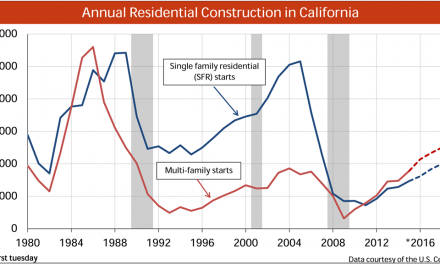California has the third-lowest average loan-to-value ratio (LTV) in the U.S., behind Hawaii and New York. The average LTV in California is 47% as of the first quarter of 2017, according to CoreLogic.
In other words, the average California homeowner has more home equity than homeowners in most other states. More equity means a greater ability to sell and relocate, which is necessary for a healthy housing market and broader economy.
The average LTV across the state is:
- 62% in Riverside;
- 59% in Sacramento;
- 50% in Los Angeles;
- 57% in San Diego;
- 43% in San Francisco; and
- 39% in San Jose, according to Zillow.
Compare this to the average U.S. LTV of 62%.
Younger homeowners tend to have higher LTVs than older homeowners, who have many more years to build equity. For instance, in Los Angeles, Millennials have an average LTV of 66%, compared to 46% for Baby Boomer homeowners.
More equity… less turnover
On the surface, California’s low LTVs appear to be great news for homeowners. However, this statistic is more nuanced on a closer examination. California’s low LTV is indicative of the vicious cycle in which California’s housing market is trapped.
The reason California LTVs are so much higher than average is due to the rapidly rising home values here. This is especially evident in the state’s highly sought after coastal areas, where home prices have recently risen as much as 40% in a single year. This is typically a good thing for homeowners, as higher home values translates to bigger profits when they choose to sell, and a larger down payment for their next home.
However, with the fast increase comes a tandem slowdown in home sales volume. First-time homebuyers are unable to keep up with higher prices and inventory has slowed. Would-be sellers are hesitating, choosing to wait to list since the lack of inventory makes them concerned about finding replacement property. Sellers also sense that waiting can yield only one thing: ever higher prices.
This contributes further to the inventory shortage. Along California’s coasts, the number of homes sold is 12%-30% below a year earlier as of mid-2017, according to Zillow.
What is needed for a more healthy home sales volume and steady (modest) home price increases?
The answer is ultimately more residential construction.
Construction today is stuck at a fraction of what is needed to keep up with demand from our every-growing population. In 2016, multi-family construction actually fell from the previous year, while single family residential (SFR) construction rose only slightly. Meanwhile, demand continues to build up from buyers and renters alike. When that demand is finally met by a higher rate of construction, it’s entirely likely the bottom will simply drop out from home prices with the deluge of new home inventory.
Better for the housing market will be a modest growth in construction — starting now. Consistent and gradual additions to the housing stock will result in a gradual pullback in home prices, and a return to a healthier home sales volume.



















